How long does the hiring process take in tech?

When joining the interview process, candidates often ask “How long does the hiring process take at your organization?” and they have a reason to do so. Filling open racks in tech is taking more time than ever with the average length of the interview process reaching 24.4 days for Internet & Tech jobs and 23.9 days for Computer Software and Hardware positions.
In this post, we look at how long does the hiring process take and propose ways of speeding it up.
- How long does the hiring process take in tech?
- How long does the hiring process take: effect on the Quality of Hire
- How long does the hiring process take: financial impact
- How long does the hiring process take: employee & team impact
- How long does the hiring process take: employer brand & candidate experience impact
- What can you do to speed up your hiring process?
- How long does the hiring process take? Final thoughts
How long does the hiring process take in tech?
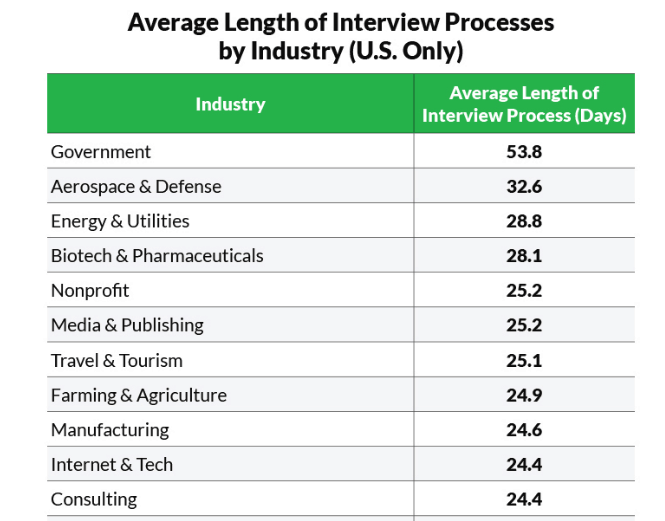 Source: Glassdoor
Source: Glassdoor
According to Glassdoor data, government jobs come with the longest interview process (53.8 days) with restaurant and bar positions coming last (10.2 days). The average length of the interview process depends on the skills necessary to perform the job in question, whether these skills are in high demand and whether they are easy to screen. If you think that’s slow, have a look at Glassdoor’s list of 25 jobs with the longest interview processes in the United States (January 1, 2017, to June 13, 2017). Software Development Engineer ranks sixth on with 40.8 days on average. This means that the question “How long does the hiring process take?” is more than relevant when it comes to IT jobs.
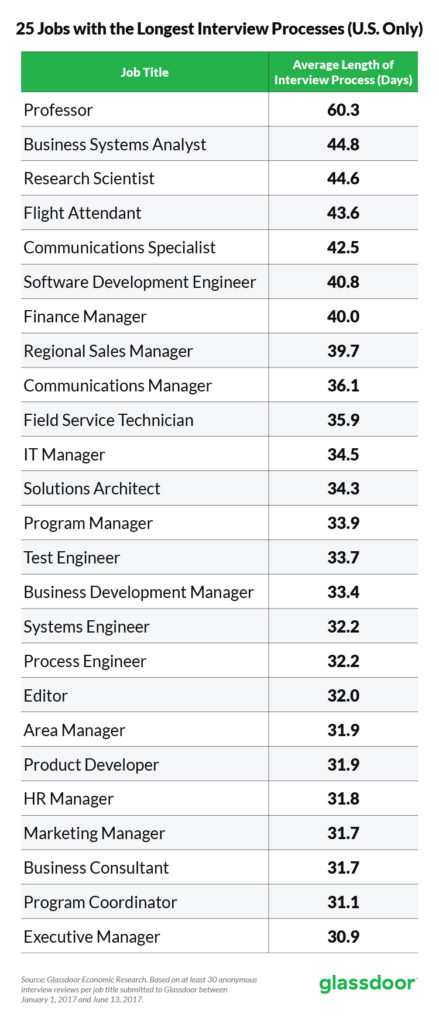
Source: Glassdoor
How long does the hiring process take: effect on the Quality of Hire
Speed is of utmost importance when hiring most sought-after candidates like software developers, especially in the case of STEM jobs. Because the majority of developers are currently employed, they don’t feel pressured to actively look for jobs which makes them even harder to recruit.
 Source: 2017 Developer Hiring Landscape
Source: 2017 Developer Hiring Landscape
Tech workers are in very high demand and when they start looking for a new job or even update their LinkedIn profile, they get inundated with requests and offers. Unless you are a REALLY big player, people will not wait for you and decline other offers while waiting. As your recruitment process expands over time, two things are likely to happen:
- Your candidate pool shrinks,
- You are left with average and weak candidates.
On such occasions, you typically resort to refilling your vacancies with whoever you have left in your pool, who are typically lower quality hires. Instead, you should be asking yourself “How long does the hiring process take for me?” and “Why is it so long?”.
The consequences of slow hiring are manifold, so you should really take a moment and ask yourself “How long does the hiring process take in my organization?”. The answer you come up with has a massive impact on your business because long hiring processes affect revenue, employer brand, candidate experience, as well as team spirit and motivation of individual workers.
How long does the hiring process take: financial impact
You might be tempted to think that open positions save you money, but they do the opposite. Do you know the exact cost of your vacant positions? Amara Miller, senior technical recruiter for Silicon Graphics International (SGI) says that to estimate how much each vacant position costs you, you need to divide “the company’s total revenue by the number of employees and divide that by the number of working days per year (220) to calculate the daily lost revenue.”
When vacant positions stay open for too many days, you lose significant revenue and productivity. Let’s start with product development issues. Here’s Dr. John Sullivan’s breakdown of what happens when you delay product development in an industry such as tech:
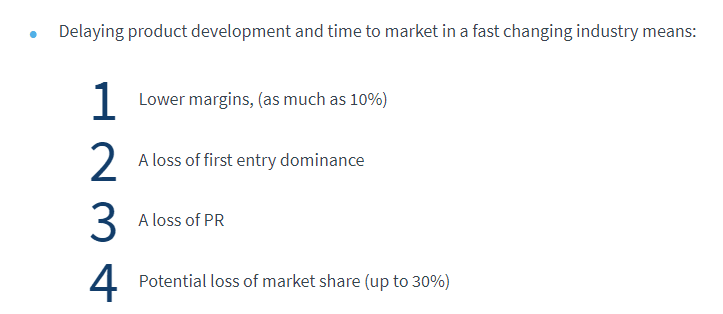 Source: ERE Recruiting Intelligence
Source: ERE Recruiting Intelligence
But delayed product development is only the tip of the iceberg. Bugs and bad technical support lead to a decrease in customer satisfaction. They put your company at risk and may even make existing customers churn out. It is possible for a single understaffed department to impact the work of the entire department because “departmental schedules and plans are closely interwoven”. It’s also more difficult to meet targets and get more customers on board.
How long does the hiring process take: employee & team impact
When vacant positions put a strain on existing employees, they become frustrated and are less productive as a consequence.

Your current employees need to fill in for open positions and cannot focus on their own work fully which is detrimental to idea generation. What is more, in team environments, “disruption in team cohesiveness may occur”.
What is more, it’s also harder for understaffed departments to achieve growth through learning new things. Dr. Sullivan rightly points out that they rarely have time to send people to conferences and training.
How long does the hiring process take: employer brand & candidate experience impact
Long hiring processes are highly detrimental to your employer brand you work so hard to build and protect. Employer branding damages pose a threat to hiring top professionals in the future, as 94% of candidates favour companies actively managing their employer brand (Bernard Hodes Group via TalentAdore). However, weak employer brand has financial consequences, too. If you don’t have a strong brand, you need to make up for it with a 10% higher pay.
When tech professionals are involved in a slow hiring process, they typically start questioning whether companies who think in weeks and not days are a fit for them. Example?
“If it takes them a week to respond to a resume like mine for a job of this importance, they’re not the kind of company I want to work for. I move fast, and I can already see that my style wouldn’t fit their culture.” —Wind River Associates via ERE.
When hiring in a competitive quickly developing industry, you don’t want to be seen a slow decision maker.
What can you do to speed up your hiring process?
There are a number of ways to decrease the average hiring process length – here are some of them.
1. Choose the right screening methods
 Source: Glassdoor
Source: Glassdoor
You need to select the best tools to shorten the time screening takes you. Focus only on the screening procedures which are REALLY necessary for the position. Do you need group panel interviews? Does the extra time it takes you to find a date which suits everyone make up for what you can learn about your candidates instead?
In the case of developers, you should focus on skills because that’s what makes them so valuable as employees. The best way to do it is to test the knowledge of programming languages, frameworks, and libraries.
Available “research concerning work sample testing suggests that they can produce high predictive validities” as well as reduce the impact of unconscious bias.
LEARN MORE: The science behind HR: what you need to know to recruit top talent in IT
Skill screening software works to your advantage because it allows you to gather reliable work samples in a short period of time. The ideal scenario is to collect these samples through tasks resembling real work to be done if hired – this increases the chances of finding the right fit for the position.
From the perspective of the HR department, a good platform for verifying programming skills should be flexible and allow to use ready-made tests as well as design custom tests. It should also be easy to set up for non-technical employees to avoid putting too much strain on the IT department and prevent bottlenecks.
2. Find out how long it takes for top candidates to drop out
According to Arti Bhargava (CHRP), the best way to do it is to identify “the top 10 percent of your applicants and then periodically contacting each of them to see how many days pass before they move on (it is usually between 10 and 20 days).”
You can also go through historical data and see when your top candidates dropped out in the past. Since we’re talking about analyzing historical data, a great tip is to leverage most promising past applicants who you didn’t select or who dropped out when you were recruiting before. Reach out to inquire about their current status and see if they’re still interested in joining your company.
3. Be prepared to answer the question “What are the next steps? How long do you anticipate the process to take time?”
Best developers have projects lined up and they want to know how long things take on your end. For that reason, you need to be able to inform them how long before you can give them an answer. At this point, I’d like to remind you that you should notify all unsuccessful candidates that you’ve selected someone else and thank them for their time.
4. Get a second (and third) opinion
The wisdom of crowds might be of help when estimating the weight of an ox (read about this experiment conducted by British statistician Francis Galton here), but does candidate assessment prove more successful when carried out by multiple reviewers? In an online study conducted by Behavioural Insights Team, 398 reviewers were asked to independently rate interview responses to a generic recruiting question. The responses assessed came from four unnamed hypothetical candidates.
Statistical simulations based on study findings indicate that “with more people, you are more likely to correctly identify the best person. Or, put another way, with more people you’re less likely to accidentally pass over your best candidate.”
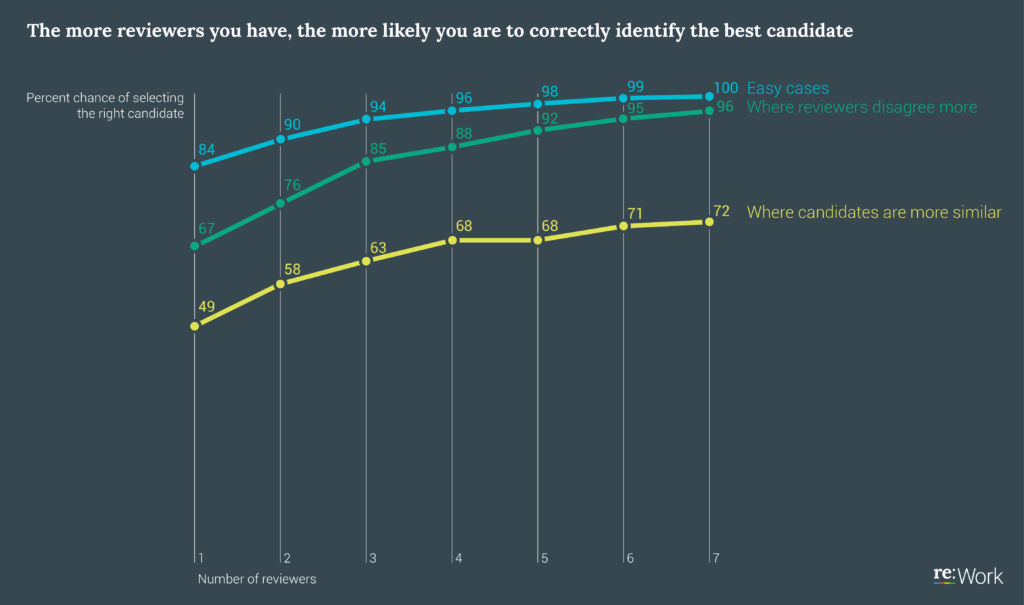
Source: re:Work
The chance for selecting the wrong person by people reviewing candidate answers is as follows:
– on their own: 16%,
– in a group of three: 6%,
– in a group of five: 1%.
Consider running fewer interviews but bringing more people to vet your candidates. Remember multiple encounters and multiple points of touch are likely to yield the best results but be careful not to make the process even longer than it is.
5. Don’t organize more interviews than you need (aka “the rule of four”)
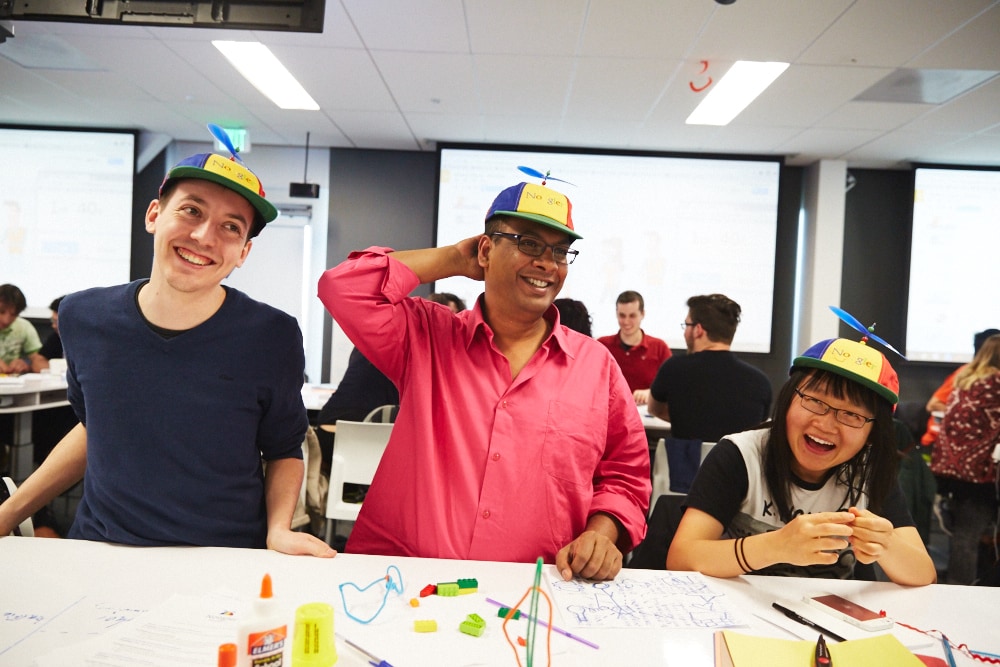
Source: re:Work
Do you know how many interviews it now takes to hire a new Googler? Staffing team at Google looked at their past data and determined that “four interviews was enough to make a reliable hiring decision.” As you can see on the graph below, after the initial spike (interview 1-4) the increase in accuracy is less prominent (interview 4 onwards).
According to @Google data, 4 interviews is enough to predict a new hire’s performance
Click to tweet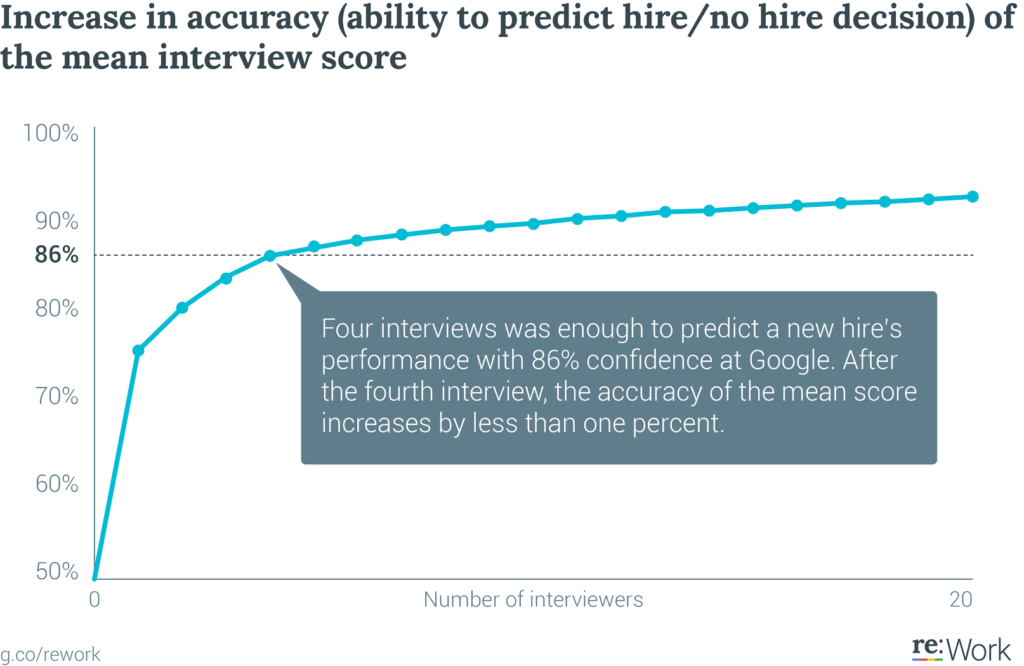
Source: re:Work
6. Simplify the application process
According to iCIMS Hire Expectations Institute™ recruitment marketing survey, “86% of HR professionals agree that recruitment is becoming more like marketing.” Due to candidate-centrism, recruiters need to sell the company to the candidate to make a hire, just like marketers do with products and services.
LEARN MORE: The candidate-centric approach to hiring: 10 lessons from Jill Macri (Airbnb)
When designing the application process, recruiters should try to imitate marketers in how they optimize the marketing funnel. Look for areas and requests which make most of your applicants drop out.
The more steps a candidate has to take, the more likely he or she is to bail. Make sure your application process provides you with basic information to help you decide if you want to investigate any further, but bear in mind it’s your job to verify who the candidate is. There are a number of things you can do get an idea of what they might know i.e. look at their social media profiles, check their Stack Overflow reputation and go through their GitHub repositories.
7. Don’t make your interviews too easy
If your interviews are too easy, you essentially devote time to confirm people who applied have the very basic coding skills, but you’re still unable to single out your top candidates. In other words, you add more time to a very time-sensitive process and learn nothing in doing so. The best solution is to adjust interview difficulty to the open position and screen programming skills early in the process before you spend hours going through all the accomplishments of the candidate or decide to meet them in person.
Interestingly, adequate interview difficulty has an impact on employee satisfaction. Glassdoor research suggests that “more difficult job interviews are statistically linked to higher employee satisfaction across six countries (…) examined” including U.S., UK, Canada, Australia, Germany, and France.
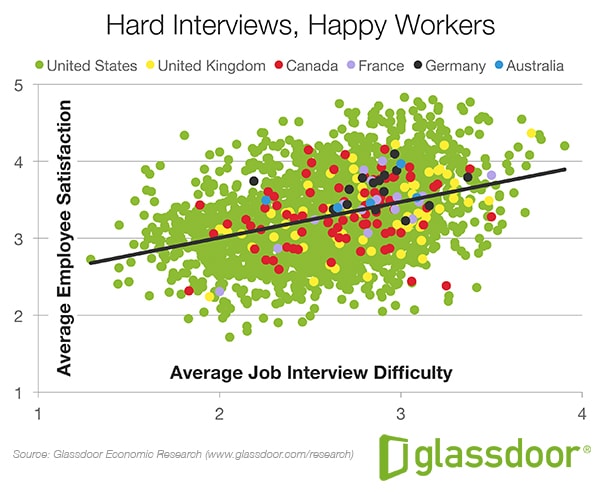 Source: Glassdoor
Source: Glassdoor
The study revealed that “the optimal or ‘best’ interview difficulty level in every country is 4 out of 5—an interview experience that is difficult but not overwhelmingly so for candidates.”

Source: Glassdoor
These findings show the importance of appropriate screening methods which not only shorten the recruitment process but also allow to adjust test difficulty to the position.
How long does the hiring process take? Final thoughts
In the case of tech jobs, speed is life. If you’re asking yourself the question “How long does the hiring process take”? you’re doing the right thing. Recruiters in tech have a tough nut to crack. Not only do they have to lure in top candidates who are passive and in most cases well taken care of, but they also need to be quick to do so. In a fast-moving industry sector such as tech, you need to give off the right signals to appeal to the minds of people who value mobility and innovation. Sadly, long hiring processes send the opposite signal and it’s your duty to speed things up if you want to hire the best programmers out there.
In the case of your organization, how long does the hiring process take? What are your tried and true techniques of speeding it up?
Share post